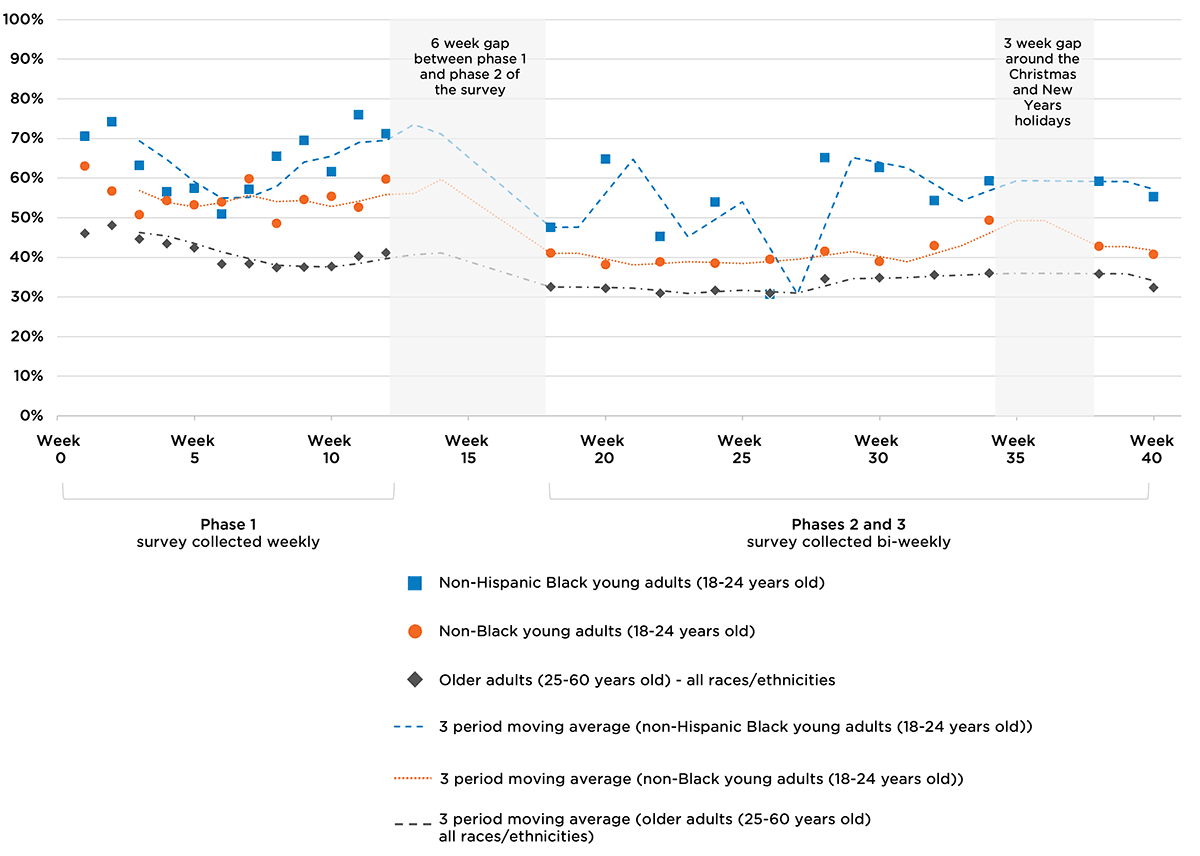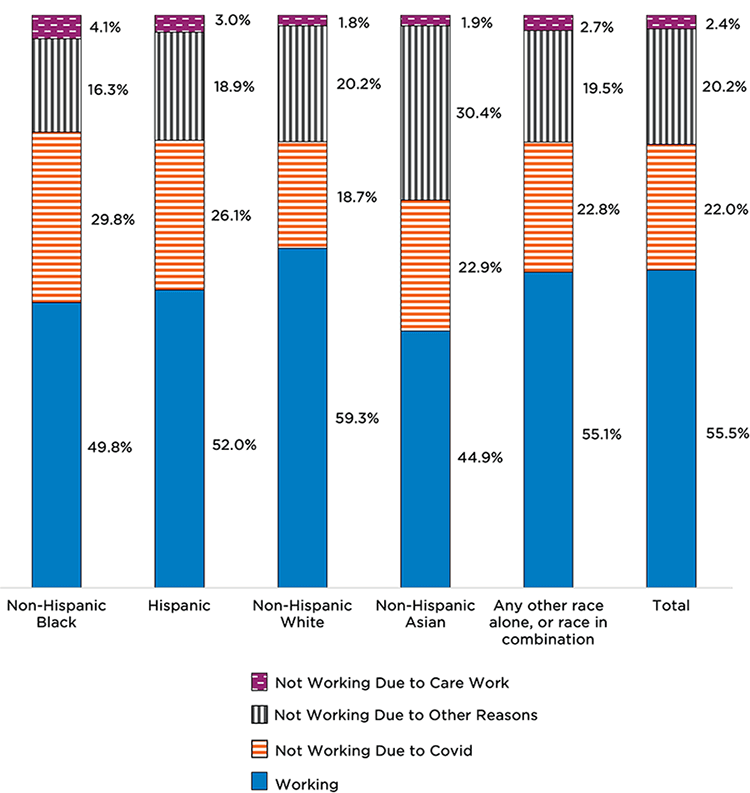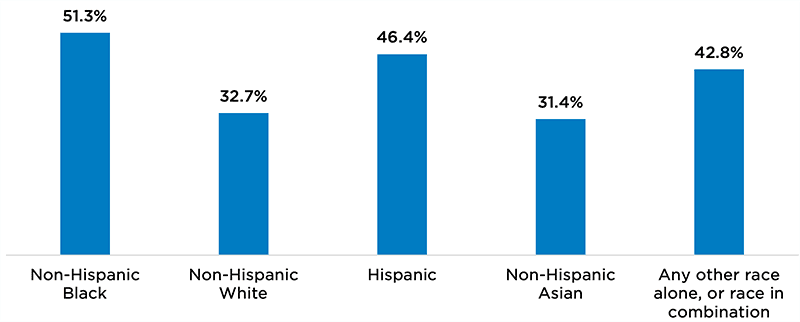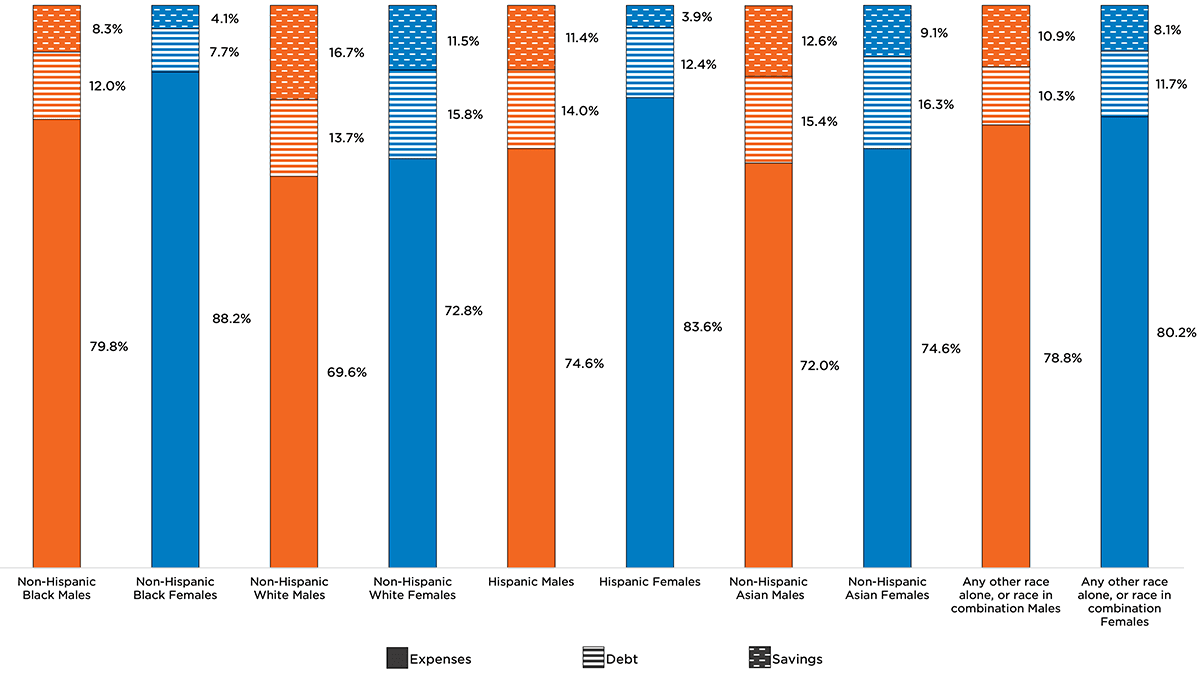COVID-19 Recession Hits Black Young Adult Employment Especially Hard
Early adulthood is an important developmental period for gaining work-related skills and experience. However, during economic downturns—such as the ongoing COVID-19 pandemic recession of 2020 and 2021—Black young adults are particularly likely to face challenges with employment. This is driven by two factors. First, young adults have lower levels of employment than older working-age adults, even during periods of economic growth and prosperity. Additionally, structural racism limits employment opportunities for Black individuals, regardless of age. This brief explores the work experience of non-Hispanic Black young adults during the COVID-19 pandemic, and how their experience compares to that of young adults from other racial and ethnic groups.
Our findings confirm that non-Hispanic Black young adults have been hit hard by the COVID-19 pandemic. (Our analyses compared mutually exclusive groups of individuals who are non-Hispanic Black, non-Hispanic White, non-Hispanic Asian American, or non-Hispanic and any other race or combination of multiple races, as well as those who are Hispanic. For brevity, we subsequently refer to those who are non-Hispanic simply as Black, White, Asian American, or some other race or multiple races.)
Findings
- Among Black young adults, 3 out of 10 (29.8%) reported that they weren’t working due to COVID-19 (for reasons such as loss of employment or illness due to COVID-19). For young adults of other racial or ethnic groups, this percentage ranged from 18.7 to 26.1 percent.
- This disparity in COVID-19-related work status parallels racial disparities in work status among young adults in general, with the exception of Asian American young adults. Throughout the pandemic, Black young adults have been more likely to be non-employed—regardless of the reason for non-employment—than those who are Hispanic, White, or of another race or multi-racial. Here, we classify respondents who did not work for pay or profit in the last seven days as non-employed. However, Black young adults were less likely to be non-employed than young adults who are Asian American (50.2% and 55.1%, respectively). Further, among all those not employed, the primary reason for non-employment was more likely to be related to COVID-19 among young adults who are Black than among any of the other four groups.
- Regardless of race or ethnicity, young adults (ages 18 to 24) were more likely than older working-age adults (ages 25 to 60) to not be working (44.5% and 33.0%, respectively).
- Difficulty paying bills was more common among Black young adults (51.3%) than among their peers of other races and ethnicities (ranging from 31.4% among Asian American young adults to 46.4% for Hispanic young adults). When considering race and ethnicity together with sex, COVID-19-related financial difficulties were particularly marked among young women who are Black. For example, 88.2 percent of Black women planned to use their first 2020 stimulus payment to cover expenses (as opposed to setting it aside for savings or paying down debt). For young women of other racial and ethnic groups, and among young men, this percentage ranged from 69.6 percent for White males to 83.6 percent for Hispanic females.
This analysis focuses on COVID-related non-employment during the pandemic for Black young adults, based on the U.S. Census Bureau’s Household Pulse Survey. Although non-employment differs from unemployment,[1] studies using the Current Population Survey (CPS) to examine unemployment during the pandemic have reported findings similar to ours. Black and Hispanic young adults have had the highest rates of unemployment in most months, relative to young adults from other backgrounds, with Black young adults experiencing a slower rebound starting in early summer than their peers from other racial or ethnic groups. These disparate findings reflect historical policies and the continued systemic barriers that stand in the way of many Black young adults’ economic progress—a pattern that worsens during economic downturns.
Context
Early adulthood is an important developmental period of exploration and identity formation. Many young adults attend school, enter the workforce, and participate in other activities that build valuable skills and social capital, laying the groundwork for their future employment and economic stability. A 2018 analysis by the Brookings Institution and Child Trends found that earning higher wages at age 23 predicts higher future job quality, as measured by wages, benefits, work hours, and job satisfaction, even after controlling for education levels. Working can also provide connections, skills, and labor market knowledge unavailable to those who lack access to work.
Young adults have the highest unemployment levels of working-age adults and experienced the greatest challenges recovering from the Great Recession (December 2007 to June 2009). In 2015, years after the Great Recession ended, young people ages 16 to 24 made up a disproportionately high share of the unemployed population—more than 25 percent. The same pattern of youth disadvantage is already apparent in this recession. In July 2019, 56.2 percent of youth and young adults ages 16 to 24 were employed, but by July 2020, labor force participation among this cohort had dropped nearly 10 percentage points, to 46.7 percent. Based on our own analyses of Household Pulse Survey data, from May to December 2020, young adults ages 18 to 24 were less likely to report working than either 25- to 29-year-olds or 30- to 60-year-olds.
In addition to age, disparities in employment are also present by race. Structural racism results in limited access among Black populations to employment opportunities. This contributes to income inequality and related social ills. For instance, research finds that Black workers have historically been reemployed at a slower pace than White workers, a pattern that continued during the COVID-19 pandemic.
In this brief, we report on disparities in the shares of young people who are not working [2]—as well as in young people who lack work specifically as a result of COVID-19—across racial and ethnic groups. We find that non-Hispanic Black young adults fare especially poorly on these indicators. These findings echo other reports that have persistently found that Black men and women have higher levels of unemployment, lower earnings, and less wealth, on average, compared to their White counterparts. These disparities do not exist because racial identity is linked with an inherent deficit or lack of will, interest, or capability. Instead, the disparate outcomes reflect four centuries of historical racism and ongoing policies and practices in the United States—such as discrimination in employment (e.g., in hiring or in lack of compensation), schooling, and transportation—that result in unequal access to opportunities and resources.
Methodology
This brief uses the U.S. Census Household Pulse Survey to explore non-Hispanic Black (referred to subsequently as Black) young adults’ employment status and their reasons for not working during the COVID-19 pandemic. The Pulse Survey data were collected over three phases. Phase 1 of the survey ran from April 23, 2020 through July 21, 2020 and collected data weekly. Phase 2 ran from August 19, 2020 through October 26, 2020 and collected bi-weekly data. Phase 3 also collected bi-weekly data and began October 28, 2020; after a short break around the holidays, Phase 3 continued through March 1, 2021. To conduct the analysis, we used data collected from April 23, 2020 to February 1, 2021. This represents data from phases 1 and 2, along with the first five releases from Phase 3.
We defined young adults as those ages 18 to 24. We looked at how Black young adults were faring compared to older adults and to young adults of other racial and ethnic groups, and assessed differences by gender.[3] Unless otherwise noted, all differences reported in this brief are statistically significant. Small sample sizes precluded the Census Bureau from releasing data on the experiences of American Indian or Alaskan Native young adults. These respondents are most likely in the “other racial category” group. This is particularly unfortunate, given that Census data show that employment rates for working-age American Indian and Alaskan Native adults have been lower than among either Black or White people during the pandemic.
We defined someone as not working due to COVID-19 if they reported that they had not worked during the past seven days, and that their primary reason for not working was one of the following: they were sick with coronavirus symptoms; they were caring for someone with coronavirus symptoms; they were furloughed or laid off due to the pandemic; they feared getting or spreading the coronavirus; or their employer was temporarily closed or went out of business due to the pandemic. Not included in our definition are people who were not working due to care-taking responsibilities, such as caring for a child or an elderly person. There was no way to determine whether these caregiving responsibilities were related to COVID-19 closures, so they are categorized separately. Finally, we categorized as “other reasons for non-work” those who did not want to be employed, were retired, were sick or disabled for reasons not related to COVID-19, or were not working for some other reason. In our analyses, we also explored rates of non-employment, regardless of the reasons for not working.
Findings
In most weeks, among young adults who were not working, those who are Black were the most likely to report that COVID-19 was their reason for not working.
Black young adults regularly saw both high rates of COVID-19-related non-work and more volatility in this pattern than either other young adults or older workers. While young adults were overall more likely than older adults to attribute their lack of work to COVID-19, Black young adults stood out in particular.
In late July 2020 (week 12 in Figure 1), 71 percent of non-working Black young adults reported COVID-19 as their primary reason for not working. By comparison, 60 percent of non-working young adults who belong to another racial or ethnic group reported the same. A smaller share (41%) of non-working older adults (ages 25 to 60) of any race or ethnicity who were not working reported a COVID-19-related reason. While the gap had narrowed slightly by December 2020 (week 34 in Figure 1), disparities remained across age groups and races/ethnicities. In December, among non-working adults, 59 percent of Black young adults were not working due to COVID-19, compared to 49 percent of young adults who belong to another racial or ethnic group and 36 percent of older working-age adults of any race or ethnicity. By February 2021 (week 40), the difference between Black young adults and other young adults had increased again (55% for Black young adults, 41% for young adults of another race or ethnicity, and 32% for older adults), indicating a slower and more volatile recovery for Black young adults. Figure 1 shows week-by-week rates and a three-period moving average for Black young adults (blue), young adults of another race or ethnicity (orange), and older adults ages 25 to 60 (gray).[4]
Figure 1. Among non-working non-Hispanic Black young adults, other young adults, and older adults of all races/ethnicities, percentage who reported COVID-19 as their primary reason for not working, by week of Pulse data collection

Source: Pulse Data, U.S. Census Bureau, April 23, 2020 – February 1, 2021
Note: A three-period moving average calculates the average of the three previous data points and then generates a line. In weeks 1 and 2, no average is calculated. But in week 3, the line represents the averages of the data points from weeks 1, 2, and 3. For week 4, weeks 2, 3, and 4 are averaged, and so on. The line on the figure shows these averaged points over time.
Fewer than half of Black and Asian American young adults interviewed during the April 2020 to February 2021 time period reported that they were working.
Black young adults reported lower levels of employment (49.8%) during the pandemic than most other young adults, with the exception of those who are Asian American (44.9%). Low, but slightly higher, levels of young adults from White (59.3%), Hispanic (52.0%), and other (55.1%) backgrounds reported working. (See Figure 2.)
Among young adults of various racial and ethnic groups, those who are Black were the least likely to be non-employed specifically for a reason other than COVID-19 or caregiving responsibilities (16.3%).
In contrast, as shown in Figure 2, nearly one third of Asian American young adults (30.4%) reported that they were not working and that their reason was something other than COVID-19 or caregiving. Some of these young adults, including Asian Americans, may have been non-employed due to school enrollment; the survey did not ask whether respondents were not working because they were in school. In fact, other Census data suggest high levels of school enrollment among Asian Americans ages 18 to 24.
Additionally, some Asian American young adults may not be working for fear of harassment; unfortunately, this has increased during the pandemic. Additional exploration into other reasons why young adults are not working (especially Asian Americans) would shed light on the extent to which these young adults are positively engaged in alternate activities. It is noteworthy that the most common reason reported by Asian Americans (18.2%) was “I did not want to be employed at this time.”
Over the months that the Pulse survey data were collected, half of all Black young adults (50.2%) reported not working; among those not working, COVID-19 was the main reason for over half.
Overall, approximately one in five young adults (22.0%) were not employed and identified a COVID-19-related factor as the primary reason (including their own illness, work loss, or related factors). However, those who are Black were the most likely to be non-employed due to COVID-19 (29.8%), closely followed by Hispanic young adults (26.1%). By comparison, 18.7 percent of White young adults reported not working because of COVID-19.
In addition to COVID-19, Black young adults were the most likely not to be working due to caregiving responsibilities (4.1%).
Overall, few young adults (2.4%) reported not working due to caregiving responsibilities, such as caring for a child or a sick relative. This means that the proportion of Black young adults not working due to caregiving responsibilities is almost twice as high as the average across all racial or ethnic groups. While many care responsibilities were present prior to COVID-19, these have increased for many people in the past year: Many children have been out of school or engaged in remote schooling, and older adults may have felt less safe or required additional care.
Figure 2: Distribution of 18- to 24-year-olds by employment status and reasons for not working, by race and Hispanic origin

Source: Pulse Data, U.S. Census Bureau, April 23, 2020 – February 1, 2021
More than half of Black young adults reported that it was somewhat or very difficult to pay expenses in their household.
Difficulty paying household bills was most common among Black young adults (51.3%), but was also common among those who are Hispanic (46.4%) and among young adults of other races (42.8%). Nearly one in three White and Asian American young people had difficulty paying their bills (see Figure 3).
Figure 3: Percentage of young adults who reported that paying expenses was somewhat or very difficult, by race and Hispanic origin

Source: Pulse Data, U.S. Census Bureau, April 23, 2020 – February 1, 2021
Compared to both young men of all races and ethnicities and to young women of races and ethnicities other than Black, a larger proportion of Black young women intended to spend their pandemic stimulus check on expenses.
Before stimulus checks were sent out, respondents were asked how they intended to use them. Questions about intended stimulus use were asked in June and July 2020 (regarding the first stimulus). Figure 4 shows differences by race and ethnicity regarding intended use of the first stimulus check.
Among young Black women, 88.2 percent intended to spend their stimulus on expenses. This was a higher proportion than among women of other races or ethnicities (as shown by the blue bars in Figure 4), and among men of any race or ethnicity (as shown by the orange bars). For example, 74.6 percent of Asian American young women intended to spend their stimulus on expenses, as did 72.8 percent of White young women. Only a small fraction of young adult Black (7.7%) and Hispanic (12.4%) women intended to spend their stimulus checks to pay down debt.
Figure 4: How young adults reported intending to spend their stimulus checks (June 4-July 14), by gender

Source: Pulse Data, U.S. Census Bureau, June 4, 2020 – July 14 (Weeks 6-11), 2020
Conclusion
Black young adults have been especially hard-hit economically by the COVID-19 pandemic. Over the months of Household Pulse Survey data collection from April 23, 2020 to February 1, 2021, 50.2 percent of Black young adults reported not working. About one third of Black young adults were not working for a reason related to COVID-19, such as personal or family illness or related job loss. This is higher than the one fifth of all young adults who were not working as a result of the pandemic (see Figure 2, far-right column [22%]).
Although there are not yet published studies that explain why Black young adults are less likely to be working, and why they are experiencing financial hardships due to COVID-19, many factors may be at play. Black (and Hispanic) young adults are less likely to work in jobs that enable them to telework, which may increase their likelihood of contracting COVID-19. On average, Black adults also have less wealth than their White counterparts, so they have fewer assets and resources to draw on when navigating difficult financial circumstances. In addition, public health research has consistently demonstrated that Black adults in the United States appear to suffer more serious and detrimental health effects and higher mortality rates from COVID-19, which could impact both the number of young adults who experience illness themselves and the number who may need to take on both formal and informal care-taking responsibilities. Historical and persistent racism in employment and racial economic inequality also help explain these and other racial and ethnic differences in employment.
Findings from this analysis suggest that efforts should focus on helping young people who want to work find employment and should, in the near term, provide ongoing support to help meet their urgent financial needs. This will be particularly important as some industries, such as hospitality and service industries, are projected to continue to shrink in the coming decade. Practitioners and policymakers must tailor support to young adults through connections to work-based learning opportunities, which have been found to show promise for young adults of color, or ongoing relationship-based skill development opportunities, but young adults cannot take on the full responsibility. Policymakers and community advocates should educate employers on the strengths of young adults as employees and encourage their hiring.
It’s important that researchers and policymakers continue tracking how young adults are faring during and after the pandemic. This continued attention can inform decisions and help target resources within communities—especially Black, Indigenous, Hispanic, and other communities of color that may be especially hard-hit by the pandemic.
Notes
[1] Non-employment means that a respondent did not work for pay or profit in the last seven days. By contrast, unemployed individuals are able to work, looking for a job, and not working. See the Bureau of Labor Statistics for more information: https://www.bls.gov/cps/cps_htgm.htm.
[2] The Pulse survey asked respondents whether “they worked in the last seven days.” If they did work, we assumed they were employed. If they did not work, we interchangeably refer to them as non-working or not employed. It is plausible that some of these young adults are employed and simply had not worked over the past week, but this information is not discernible from the available data.
[3] Because the data for this report are drawn from the U.S. Census, we are adopting their use of terms for racial and ethnic groups (White, Black, Asian American, American Indian, Hispanic, and other), with a few small exceptions. We also capitalize and shorten all racial and ethnic group labels for simplicity and consistency.
[4] The differences in a logit regression between non-Black young adults and older adults of all races—in terms of reporting a COVID-19-related reason for why they were not working—are not statistically significant (when week is controlled for in the regression). This is likely driven by the fact that non-Black young adults report higher levels of “other” reasons for their non-work and that the gap between the two narrows significantly in the latter half of the year.
© Copyright 2024 ChildTrendsPrivacy Statement
Newsletter SignupLinkedInThreadsYouTube